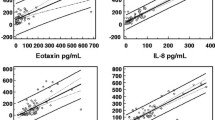Plasma concentrations of cytokines and metabolic hormones and their association with vulnerable atherosclerotic plaques were studied in 36 overweight men (age 40-77 years; BMI 25.0-29.9 kg/m2) with coronary atherosclerosis who underwent coronary endarterectomy. According to histological analysis, the patients were divided into two groups: with stable (17 (47.2%) men) and vulnerable (19 (52.8%) men) plaques in the coronary arteries. The plasma levels of cytokines and metabolic hormones were measured by multiplex analysis: C-peptide, glucose-dependent insulinotropic polypeptide (GIP), glucagon-like peptide-1, glucagon, IL-6, insulin, leptin, monocyte chemoattractant protein-1, and TNFα. In overweight patients with vulnerable plaques, the level of glucagon was lower by 4.17 times, GIP — by 2.47 times, and insulin — by 2.1 times. At the same time, the risk of occurrence of a vulnerable plaque increases by 5.4% with a decrease in GIP concentration by 1 pg/ml irrespectively of age, as well as by 3.1% with an increase in insulin concentration by 10 pg/ml, without achieving statistical significance when included in the age model. Overweight men with coronary atherosclerosis and vulnerable plaques have lower levels of insulin, glucagon, and GIP. The levels of GIP and insulin are inversely associated with the risk of having vulnerable atherosclerotic plaque.
Similar content being viewed by others
References
Global, regional, and national prevalence of overweight and obesity in children and adults during 1980-2013: a systematic analysis for the Global Burden of Disease Study 2013. Lancet. 2014;384:766-781. doi: https://doi.org/10.1016/S0140-6736(14)60460-8
Martinchik AN, Laikam KE, Kozyreva NA, Keshabyants EE, Mikhailov NA, Baturin AK, Smirnova EA. The prevalence of obesity in various socio-demographic groups of the population of Russia. Voprosy. Pitaniya. 2021;90(3):67-76. Russian. doi: https://doi.org/10.33029/0042-8833-2021-90-3-67-76
Russian Society of Cardiology (RSC). 2020 Clinical practice guidelines for stable coronary artery disease. Ross. Kardiol. Zh. 2020;25(11):201-250. Russian. doi: https://doi.org/10.15829/1560-4071-2020-4076
GBD 2015 Obesity Collaborators. Health Effects of Overweight and Obesity in 195 Countries over 25 Years. N. Engl. J. Med. 2017;377(1):13-27. doi: https://doi.org/10.1056/NEJMoa1614362
Kologrivova IV, Vinnitskaya IV, Koshelskaya OA, Suslova TE. Visceral obesity and cardiometabolic risk: features of hormonal and immune regulation. Ozhirenie Metabolizm. 2017;14(3):3-10. Russian. doi: https://doi.org/10.14341/omet201733-10
The Vulnerable Plaque. Waksman R, Serruys PW, Schaar J, eds. London, 2007.
Dedov II, Mokrysheva NG, Mel’nichenko GA, Troshina EA, Mazurina NV, Ershova EV, Komshilova KA, Andreeva EN, Antsiferov MB, Biriukova EV, Bordan NS, Vagapova GR, Volkova AR, Volkova NI, Volynkina AP, Dzgoeva FKh, Kiseleva TP, Neimark AE, Romantsova TI, Ruiatkina LA, Suplotova LA, Khalimov YuSh, Yashkov YuI. Obesity. Clinical guidelines. Consilium Medicum. 2021;23(4):311-325. Russian. doi: https://doi.org/10.26442/20751753.2021.4.200832
Eurasian association of cardiology (EAC)/Russian national atherosclerosis society (RNAS, Russia) guidelines for the diagnosis and correction of dyslipidemia for the prevention and treatment of atherosclerosis (2020). Evraz. Kardiol. Zh. 2020;(2):6-29. Russian. doi: https://doi.org/10.38109/2225-1685-2020-2-6-29
Osaka N, Kushima H, Mori Y, Saito T, Hiromura M, Tera-saki M, Yashima H, Ohara M, Fukui T, Matsui T, Hirano T, Yamagishi SI. Anti-inflammatory and atheroprotective properties of glucagon. Diab. Vasc. Dis. Res. 2020;17(5): 1479164120965183. doi: https://doi.org/10.1177/1479164120965183
Tsygankova OV, Veretyuk VV, Ametov AS. Incretins today: multiple effects and therapeutic potential. Sakhar. Diabet. 2019;22(1):70-78. Russian. doi: https://doi.org/10.14341/DM9841
Berglund LM, Lyssenko V, Ladenvall C, Kotova O, Edsfeldt A, Pilgaard K, Alkayyali S, Brøns C, Forsblom C, Jonsson A, Zetterqvist AV, Nitulescu M, McDavitt CR, Dunér P, Stancáková A, Kuusisto J, Ahlqvist E, Lajer M, Tarnow L, Madsbad S, Rossing P, Kieffer TJ, Melander O, Orho-Melander M, Nilsson P, Groop PH, Vaag A, Lindblad B, Gottsäter A, Laakso M, Goncalves I, Groop L, Gomez MF. Glucose-dependent insulinotropic polypeptide stimulates osteopontin expression in the vasculature via endothelin-1 and CREB. Diabetes. 2016;65(1):239-254. doi: https://doi.org/10.2337/db15-0122
Nagashima M, Watanabe T, Terasaki M, Tomoyasu M, Nohtomi K, Kim-Kaneyama J, Miyazaki A, Hirano T. Native incretins prevent the development of atherosclerotic lesions in apolipoprotein E knockout mice. Diabetologia. 2011;54(10):2649-2659. doi: https://doi.org/10.1007/s00125-011-2241-2
Smetnev SA, Meshkov AN. The role of peptide hormones (adiponectin, leptin, insulin) in the pathogenesis of atherosclerosis. Rats. Farmakoter. Kardiol. 2015;11(5):522-528. Russian. doi: https://doi.org/10.20996/1819-6446-2015-11-5-522-528
Metelskaya VA, Zhatkina MV, Gavrilova NE, Yarovaya EB, Bogdanova NL, Kutsenko VA, Rudenko BA, Drapkina OM. Associations of circulating biomarkers with the presence and severity of coronary, carotid and femoral arterial atherosclerosis. Kardiovaskular. Ter. Prof. 2021;20(8):37-47. Russian. doi: https://doi.org/10.15829/1728-8800-2021-3098
Karamitsos DT. Antiatheromatic effects of insulin. Diabetes Res. Clin. Pract. 2011;93(Suppl. 1):S105-S108. doi: https://doi.org/10.1016/S0168-8227(11)70024-9
Author information
Authors and Affiliations
Corresponding author
Additional information
Translated from Byulleten’ Eksperimental’noi Biologii i Meditsiny, Vol. 175, No. 1, pp. 107-111, January, 2023
Rights and permissions
Springer Nature or its licensor (e.g. a society or other partner) holds exclusive rights to this article under a publishing agreement with the author(s) or other rightsholder(s); author self-archiving of the accepted manuscript version of this article is solely governed by the terms of such publishing agreement and applicable law.
About this article
Cite this article
Stryukova, E.V., Shramko, V.S., Kashtanova, E.V. et al. Cytokine Profile and Concentrations of Metabolic Hormones in the Blood of Overweight Men with Coronary Arteriosclerosis. Bull Exp Biol Med 175, 92–95 (2023). https://doi.org/10.1007/s10517-023-05817-y
Received:
Published:
Issue Date:
DOI: https://doi.org/10.1007/s10517-023-05817-y




